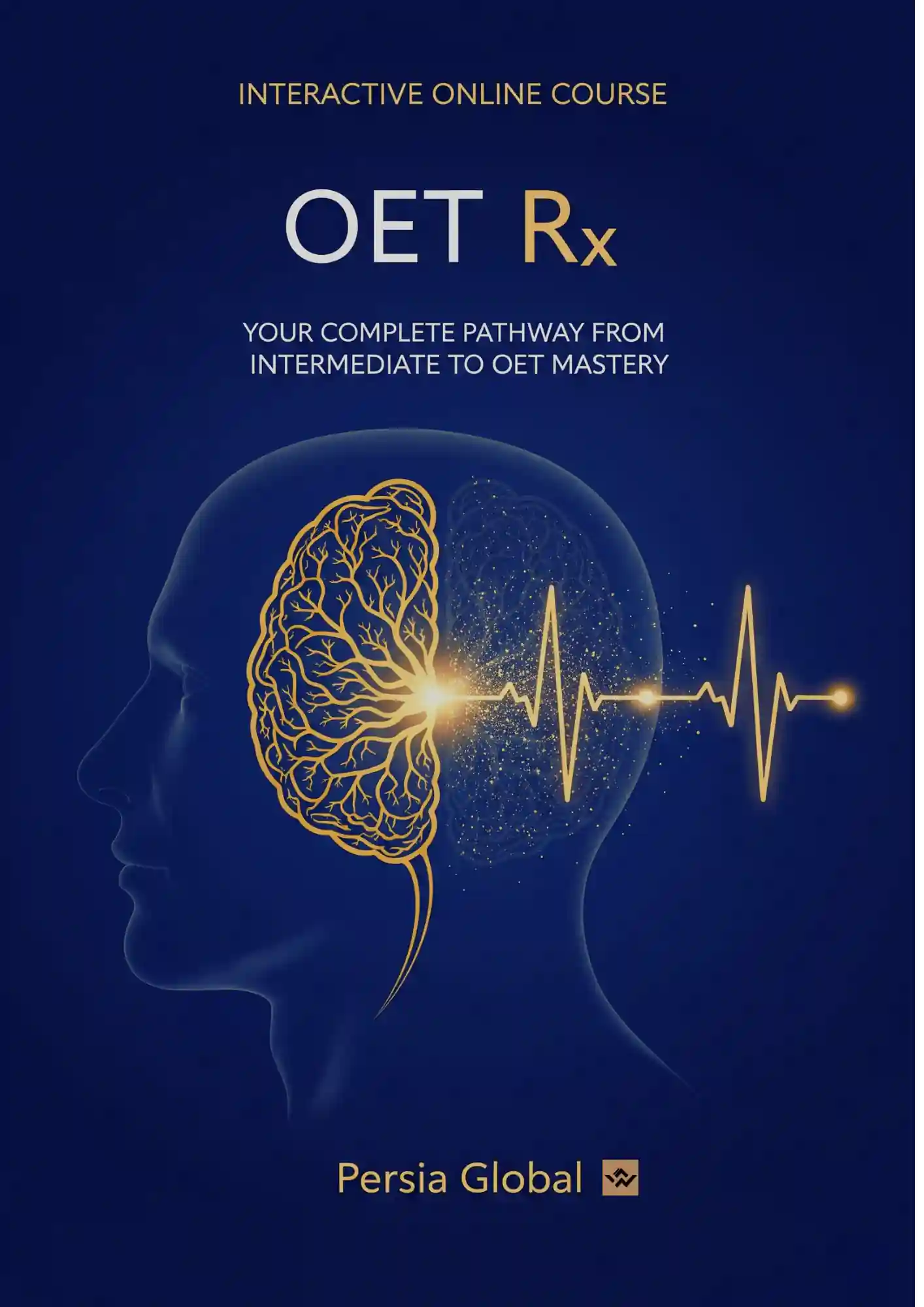OET Rx (Student Pre-Class)
Lesson 5: Taking a Detailed Patient History
Course Progress
Part 1: Lesson Objectives
By the end of this lesson, you will be able to:
- Systematically gather a patient's detailed medical history using a structured approach.
- Differentiate between Past Medical, Surgical, Family, and Social Histories.
- Ask sensitive questions in an appropriate and empathetic manner.
- Accurately document a complex patient history.
Lesson Video
Coming Soon
This video will be available for the offline course version.
Part 2: Vocabulary & Examples
Study the words, their pronunciations, Persian translations, and example sentences to understand how they are used in context.
General Vocabulary
پیچیده
Because the patient has multiple chronic illnesses, taking a complete history is a complex task that requires careful attention.
پیچیده
The patient's social situation is complicated, which we must consider when creating a sustainable treatment plan.
جزء
A crucial component of taking a patient's history is asking about their family's health history.
تمرکز کردن
I need you to concentrate and think back to exactly when the symptoms first started.
مفهوم
The concept of "Review of Systems" involves asking questions about each part of the body, even if it seems unrelated to the main complaint.
نگرانی
My primary concern is the connection between your chest pain and your family history of heart disease.
نگران
I am concerned that your symptoms have continued despite the initial treatment.
تأیید کردن
Can you confirm that you have never had any type of surgery in the past?
ارتباط دادن
I am trying to connect the onset of your symptoms with any recent changes in your lifestyle.
ارتباط
Is there any connection between the headaches you're experiencing and your high-stress occupation?
هوشیار
Was the patient fully conscious and aware of his surroundings immediately after the fall?
نتیجه
A potential consequence of not disclosing a medication allergy can be a severe adverse reaction.
در نظر گرفتن
We must consider all components of your history before we can make an accurate diagnosis.
تشکیل شده از
A complete medical history should consist of several parts, including surgical, family, and social history.
سازگار
The patient's description of the pain is not consistent with his physical presentation, which is a bit puzzling.
شامل شدن
Your medical file should contain all the relevant information about your past health.
زمینه
To understand your current problem, I need some context about your overall health and lifestyle.
ادامه دادن
Please continue telling me about your family history; this information is very helpful.
پیوسته
The patient describes the pain not as sharp, but as a continuous, dull ache in his lower back.
Medical Vocabulary
آلرژیها
Before we discuss treatment, it's crucial that I ask you about any known allergies to medications, especially antibiotics like penicillin.
بیماری مزمن
A key component of your history is managing any chronic illness, such as the diabetes you were diagnosed with ten years ago.
مدت
And what has been the duration of these symptoms? Have they been continuous for the past three weeks?
سابقه خانوادگی
Your Family History is significant because your father's heart attack at a young age is a major risk factor.
شغل
I need to ask about your occupation, as continuous exposure to dust at your workplace could be connected to your breathing problems.
آغاز
Can you pinpoint the exact onset of the symptoms? Did they start suddenly, or was it a gradual process?
بررسی سیستمها
A Review of Systems helps us to uncover symptoms you might not have considered important but could be connected to your main complaint.
شدت
On a scale of 1 to 10, with 10 being the worst, how would you rate the severity of the pain?
سابقه جراحی
Your surgical history indicates an appendectomy in your twenties, but have you had any other procedures since then?
سابقه پزشکی
Your Past Medical History is complex, so let's go through each chronic illness one by one to ensure I have all the details.
Part 3: Pre-Class Practice Tests
Reading Task:
Excerpt from a Guide to Clinical Skills
Taking a family history (FHx) is a critical component of any comprehensive medical assessment. It should not be a rushed process. A patient's FHx consists of health information about their immediate relatives (parents, siblings, and children). The primary goal is to identify patterns of disease that may be hereditary. For example, a consistent pattern of early-onset heart disease or certain cancers in a family is a significant finding. Clinicians must consider this genetic context, as it can directly influence the patient's risk profile and the choice of diagnostic tests. A well-documented FHx is a cornerstone of preventative medicine.
Question: According to the text, what is the main purpose of taking a detailed family history?
Listening Task:
Scenario: You will hear a nurse taking a pre-operative history from a patient named Mr. Evans.
Task: What information does Mr. Evans confirm about his surgical history?
Part 4: Answer Key for Pre-Class Work
Reading Answer: c) To identify potential genetic predispositions to certain diseases.
Listening Answer: c) He had a knee operation several years ago.
Part 5: In-Class Preparation
Be prepared to discuss the vocabulary and practice the following tasks in class.
Speaking Task: OET Role-Play Card
Setting: First consultation at a specialist neurology clinic.
Patient: A 45-year-old patient referred for complex symptoms including intermittent dizziness, fatigue, and memory problems over the last six months.
Task: Greet the patient and explain your role. State the goal of the consultation: to build a complete and detailed picture of their health history. Systematically take a history, including: Past Medical History, Family History, and Social History. Summarize the key points to confirm your understanding.
Writing Task:
You are the specialist from the speaking scenario. Based on the information you gathered, write the "Past Medical History (PMH)" and "Family History (FHx)" sections for the patient's new medical record.
